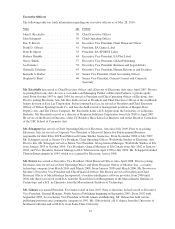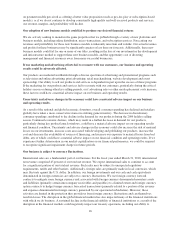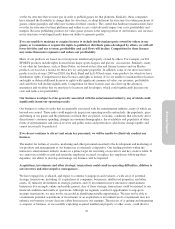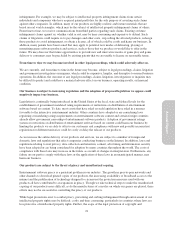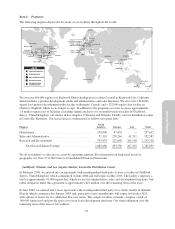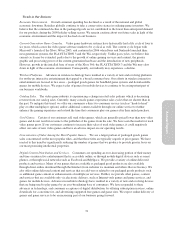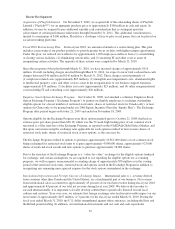Electronic Arts 2010 Annual Report Download - page 100
Download and view the complete annual report
Please find page 100 of the 2010 Electronic Arts annual report below. You can navigate through the pages in the report by either clicking on the pages listed below, or by using the keyword search tool below to find specific information within the annual report.prohibitions against the circumvention of technological protection measures to protect copyrighted works are
often under scrutiny by courts and governing bodies. The repeal or weakening of laws intended to combat piracy,
protect intellectual property and prohibit the circumvention of technological protection measures could make it
more difficult for us to adequately protect against piracy. These factors could have a negative effect on our
growth and profitability in the future.
If one or more of our titles were found to contain hidden, objectionable content, our business could suffer.
Throughout the history of our industry, many video games have been designed to include certain hidden content
and gameplay features that are accessible through the use of in-game cheat codes or other technological means
that are intended to enhance the gameplay experience. However, in several cases, hidden content or features have
been found to be included in other publishers’ products by an employee who was not authorized to do so or by an
outside developer without the knowledge of the publisher. From time to time, some hidden content and features
have contained profanity, graphic violence and sexually explicit or otherwise objectionable material. In a few
cases, the Entertainment Software Ratings Board (“ESRB”) has reacted to discoveries of hidden content and
features by reviewing the rating that was originally assigned to the product, requiring the publisher to change the
game packaging and/or fining the publisher. Retailers have on occasion reacted to the discovery of such hidden
content by removing these games from their shelves, refusing to sell them, and demanding that their publishers
accept them as product returns. Likewise, consumers have reacted to the revelation of hidden content by refusing
to purchase such games, demanding refunds for games they have already purchased, and refraining from buying
other games published by the company whose game contained the objectionable material.
We have implemented preventative measures designed to reduce the possibility of hidden, objectionable content
from appearing in the video games we publish. Nonetheless, these preventative measures are subject to human
error, circumvention, overriding, and reasonable resource constraints. In addition, to the extent we acquire a
company without similar controls in place, the possibility of hidden, objectionable content appearing in video
games developed by that company but for which we are ultimately responsible could increase. If a video game
we published were found to contain hidden, objectionable content, the ESRB could demand that we recall a game
and change its packaging to reflect a revised rating, retailers could refuse to sell it and demand we accept the
return of any unsold copies or returns from customers, and consumers could refuse to buy it or demand that we
refund their money. This could have a material negative impact on our operating results and financial condition.
In addition, our reputation could be harmed, which could impact sales of other video games we sell. If any of
these consequences were to occur, our business and financial performance could be significantly harmed.
If we ship defective products, our operating results could suffer.
Products such as ours are extremely complex software programs, and are difficult to develop, manufacture and
distribute. We have quality controls in place to detect defects in the software, media and packaging of our
products before they are released. Nonetheless, these quality controls are subject to human error, overriding, and
reasonable resource constraints. Therefore, these quality controls and preventative measures may not be effective
in detecting defects in our products before they have been reproduced and released into the marketplace. In such
an event, we could be required to recall a product, or we may find it necessary to voluntarily recall a product,
and/or scrap defective inventory, which could significantly harm our business and operating results.
Breaches of our security measures and unintended disclosures of our intellectual property or our customer
data could adversely affect our business.
We take measures to prevent our source code and other confidential information from unauthorized access. A
security breach that results in the disclosure of our source code, other confidential assets, or pre-release software
could lead to piracy of our software or otherwise compromise our product plans. When we conduct business
online directly with consumers, we may be the victim of fraudulent transactions, including credit card fraud,
which presents a risk to our revenues and potentially disrupts service to our customers. As we increase our online
businesses, we are also collecting and storing an increasing amount of customer data, some of it personally
identifiable information including credit card data. It is possible that our security controls over customer data
22


